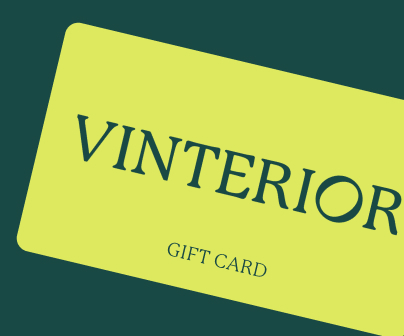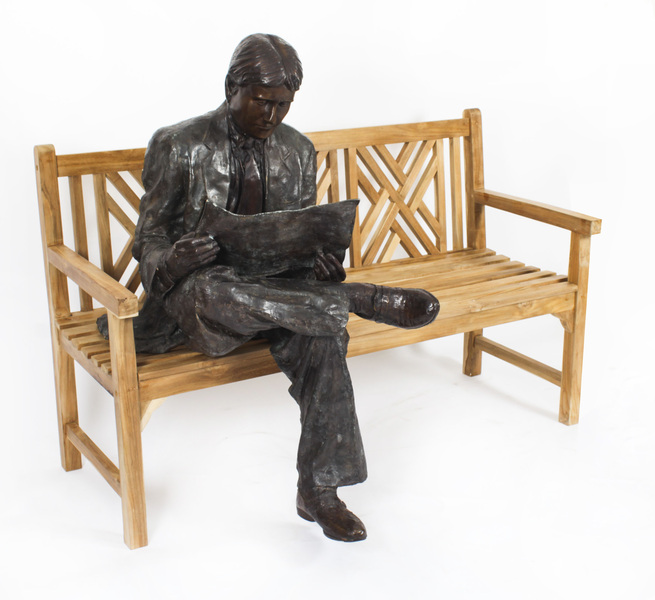Vintage Lifesize Bronze Sculpture William R Hearst 20th C
£4,550 per item
Shopping at Vinterior
-
14-day return guarantee
-
Outstanding customer service
-
Secure payment
-
Buyer protection
-
Trees planted for every purchase

Item details
Height
127.0 cm
Width
150.0 cm
Depth
58.0 cm
Wear conditions
Excellent
Wear conditions
Excellent
Shows little to no signs of wear and tear.
Good
May show slight traces of use in keeping with age. Most vintage and antique items fit into this condition.
Average
Likely to show signs of some light scratching and ageing but still remains in a fair condition.
Apparent Wear and Tear
Visible signs of previous use including scratches, chips or stains.
Please refer to condition report, images or make a seller enquiry for additional information.
Description
A truly stunning bronze sculpture of William Randolph Hearst seated on a bench reading a newspaper, dating from the late 20th century.
The bronze is beautifully cast in life size of Hearst reading a newspaper on a teak bench.
The attention to detail is absolutely fantastic and really brings this piece to life.
Add an elegant element to your garden with this lovely sculpture.
Condition:
In excellent condition, please see photos for confirmation of condition.
Dimensions in cm:
Height 127 x Width 150 x Depth 58
Dimensions in inches:
Height 4 foot, 2 inches x Width 4 foot, 11 inches x Depth 1 foot, 11 inches
William Randolph Hearst (born April 29, 1863,
San Francisco, California, U.S.—died August 14, 1951, Beverly Hills, California) was an American newspaper publisher who built up the nation's largest newspaper chain and whose methods profoundly influenced American journalism.
Hearst was the only son of George Hearst, a gold-mine owner and U.S. senator from California (1886–91). The young Hearst attended Harvard College for two years before being expelled for antics ranging from sponsoring massive beer parties in Harvard Square to sending chamber pots to his professors (their images were depicted within the bowls). In 1887 he took control of the struggling San Francisco Examiner, which his father had bought in 1880 for political reasons. Hearst remade the paper into a blend of reformist investigative reporting and lurid sensationalism, and within two years it was showing a profit.
He then entered the New York City newspaper market in 1895 by purchasing the theretofore unsuccessful New York Morning Journal. He hired such able writers as Stephen Crane and Julian Hawthorne and raided the New York World for some of Joseph Pulitzer's best men, notably Richard F. Outcault, who drew the Yellow Kid cartoons. The New York Journal (afterward New York Journal-American) soon attained an unprecedented circulation as a result of its use of many illustrations, colour magazine sections, and glaring headlines; its sensational articles on crime and pseudoscientific topics; its bellicosity in foreign affairs; and its reduced price of one cent. Hearst's Journal and Pulitzer's World became involved in a series of fierce circulation wars, and these newspapers' use of sensationalistic reporting and frenzied promotional schemes brought New York City journalism to a boil. Competition between the two papers, including rival Yellow Kid cartoons, soon gave rise to the term yellow journalism.
The Journal excoriated Great Britain in the Venezuela-British Guiana border dispute (from 1895) and then demanded (1897–98) war between the United States and Spain. Through dishonest and exaggerated reportage, Hearst's newspapers whipped up public sentiment against Spain so much that they actually helped cause the Spanish-American War of 1898. Hearst supported William Jennings Bryan in the presidential campaign of 1896 and again in 1900, when he assailed Pres. William McKinley as a tool of the trusts (the biggest companies in the United States).
While serving rather inactively in the U.S. House of Representatives (1903–07), Hearst received considerable support for the Democratic presidential nomination in 1904 and, running on an anti-Tammany Hall ticket, came within 3,000 votes of winning the 1905 election for mayor of New York City. In 1906, despite (or perhaps because of) his having turned to Tammany for support, he lost to Charles Evans Hughes in the election for governor of New York, and in 1909 he suffered a worse defeat in the New York City mayoral election. Rebuffed in his political ambitions, Hearst continued to vilify the British Empire, opposed U.S. entry into World War I, and maligned the League of Nations and the World Court.
By 1925 Hearst had established or acquired newspapers in every section of the United States, as well as several magazines. He also published books of fiction and produced motion pictures featuring the actress Marion Davies, his mistress for more than 30 years. In the 1920s he built a grandiose castle on a 240,000-acre (97,000-hectare) ranch in San Simeon, California, and he furnished this residential complex with a vast collection of antiques and art objects that he had bought in Europe. At the peak of his fortune, in 1935, he owned 28 major newspapers and 18 magazines, along with several radio stations, movie companies, and news services. But his vast personal extravagances and the Great Depression of the 1930s soon seriously weakened his financial position, and he had to sell faltering newspapers or consolidate them with stronger units. In 1937 he was forced to begin selling off some of his art collection, and by 1940 he had lost personal control of the vast communications empire that he had built. He lived the last years of his life in virtual seclusion. Hearst's life was the basis for the movie Citizen Kane (1941).
At the beginning of the 21st century, the family-owned Hearst Corporation was still one of the largest media companies in the United States, with interests in newspapers, magazines, broadcasting, financial and medical services, and cartoon and feature syndicates.
Cancellations
We offer free cancellations and full refund for orders cancelled before dispatching. View full policy.
Returns
We have a 14-day return guarantee for orders from individual sellers, within the UK and European Union. View full policy.
Free UK Mainland delivery.
Estimated delivery time
Less than one week
Free collection available
Yes
Similar Free Standing
Similar Free Standing
Choose a Wishlist
Create Wishlist
- Selling at Vinterior since 2016
- 310 sales
- Ships from London, United Kingdom
Seller Reviews
Cancellations and Returns
Last updated: 24th March 2025
We want everybody’s Vinterior experience to be seamless, so both buyers and sellers can fall in love with pre-loved. We designed our Terms of sale to treat everybody fairly.
However, sometimes things don’t go exactly to plan, and you may need to cancel or return an order.
To prevent this, we encourage you to check listings, photos and descriptions carefully before you buy. If you aren’t sure about a piece’s condition, size, provenance or shipping, just ask; click Contact seller to get in touch. Always contact your seller first if you have any queries, at any point in your purchase.
Our buyers receive the same protection when buying from all our sellers, both professional and verified.
Can I cancel an order?
There are many reasons why you might need to cancel an order, and you'll often be entitled to a refund. To cancel an order, click Create cancellation on the order page.
If you cancel your order before it has been dispatched, you will receive a full refund - including delivery costs. However, if your item has been shipped, delivery costs will not be included in your refund.
Please note: orders of bespoke, personalised or made-to-order pieces cannot be cancelled.
Can I return an order?
We understand that sometimes a piece isn’t the perfect fit. So if you no longer want your order, our returns process will ensure it finds a new home fast.
The Vinterior Guarantee included with your purchase entitles you to 14-day returns - allowing you to return any item within 14 days of the delivery date (except in specific circumstances, detailed below).
You can return your order if...
It isn't what you expected
If what arrives isn’t what you ordered, you can open a return. Just send us some photo evidence that the listing was inaccurate, misleading or misrepresented your purchased piece, and you’ll receive a refund.
You change your mind
If you don’t feel a piece is right for your space, you can return it. Once you request a change of mind return, you’ll be responsible for shipping the piece back to your seller as soon as possible. Delivery costs are non-refundable.
It's damaged in transit
In the rare event that an item arrives damaged or defective, you have a full 30 days from the date of delivery to return it for a full refund.
If your purchase arrives broken, always let us know. If Proovia delivered the piece, we can raise an insurance claim on the seller’s behalf. Or, the seller can raise a claim with their chosen courier.
What can't I return?
Just as there are some orders you can’t cancel, there are some you cant return, too. Personalised, bespoke or made-to-order pieces are non-returnable, and non-refundable. Sellers may also reject your return if the item has been altered in any way.
Please note: pieces on our site are pre-loved, not new. They may show some wear and tear; this is not sufficient grounds for a refund, unless the seller has misrepresented the item’s condition.
Lastly, neither Vinterior nor our sellers are liable for any damages or loss sustained in transit via third parties.
I'm eligible for a return. Now what?
To initiate a return, log into your Vinterior account, then go to the relevant order page and click Create a return. In the return request, be sure to include all the details: the reason for your return, an in-depth description, and photos of any issues or damage.
How will I receive my refund?
Once the seller confirms they’ve received the item (in the same condition it was sent), we will send your refund to your original payment method.
All items are inspected on return. If the seller receives the return with damage they don’t recognise, we will not be able to process your refund and the seller may need to send the piece back to you. You will be required to cover these delivery costs.
